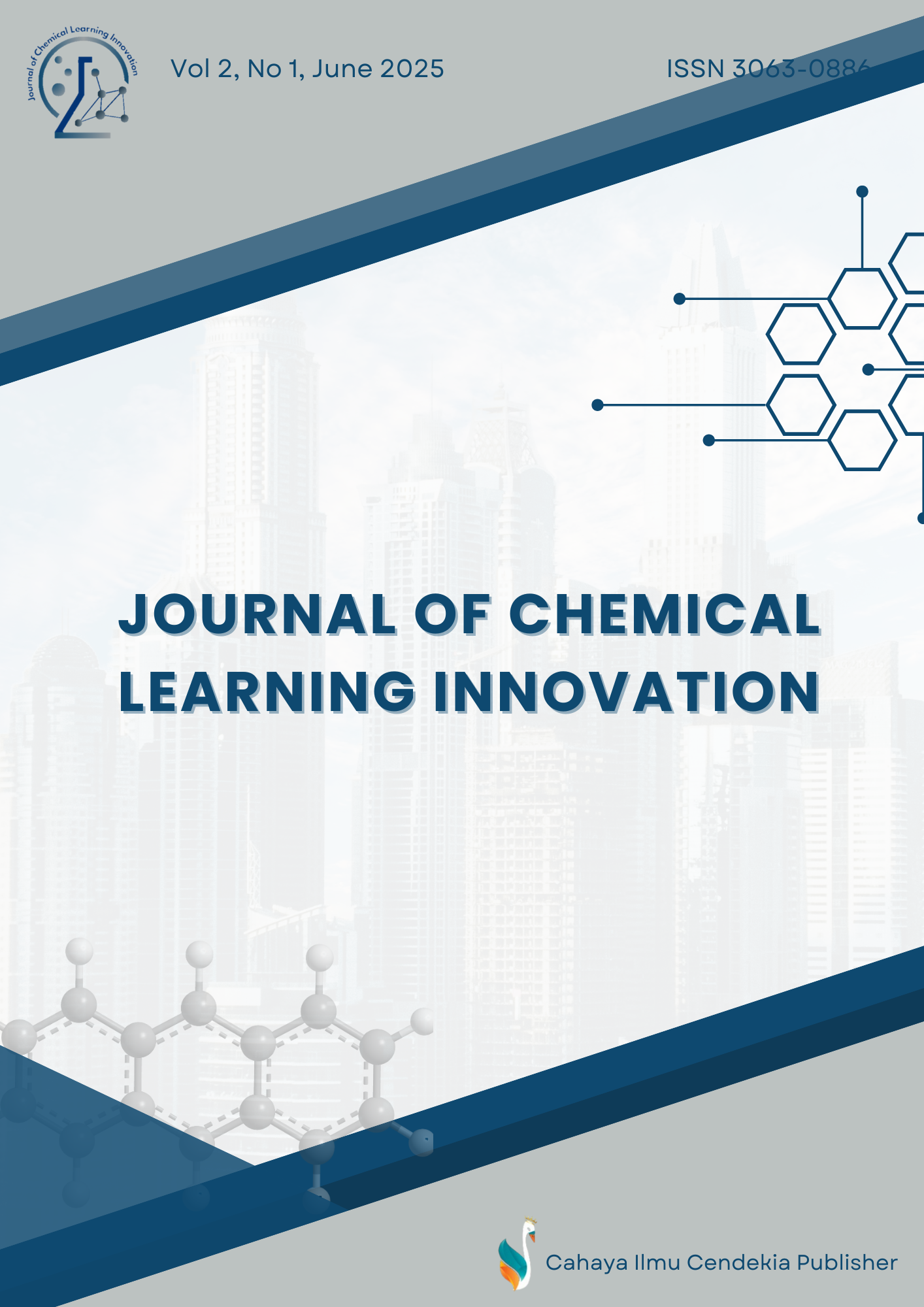Engaging Minds: The Effectiveness of Illustrated Story Handouts in Teaching Chemical Bonding
Abstract
Purpose of the study: This study aims to determine whether there is an increase in the motivation to learn chemistry of class X3 students of YLPI Marpoyan Senior High School, Bukit Raya District, Pekanbaru City through the use of handouts in the form of illustrated stories.
Methodology: The instruments used in this study are observation and documentation. Observation is done to find out the development of teachers and students in the learning process. While documentation is done to obtain school data, teacher data, and also student data.
Main Findings: Based on the results of data analysis, the percentage of student motivation before the action was 49.4%, cycle I 53.8%, cycle II 60.9%, and cycle III 76.4%, which increased at each meeting, so it can be concluded that the use of handouts in the form of illustrated stories can increase student learning motivation.
Novelty/Originality of this study: The novelty of this study is to determine the effectiveness of using handouts in the form of illustrated stories to increase students' learning motivation on the topic of chemical bonds.
References
S. O. Makinde and N. O. Oyeniyi, “The Roles of Emerging Technology in Chemistry Teaching and Learning for a Sustainable Development,” Indones. J. Teach. Sci., vol. 4, no. 2, pp. 177–188, 2024, doi: 10.17509/ijotis.v4i2.75554.
R. Wang, M. Qamruzzaman, and S. Karim, “Unveiling the power of education, political stability and ICT in shaping technological innovation in BRI nations,” Heliyon, vol. 10, no. 9, p. e30142, 2024, doi: 10.1016/j.heliyon.2024.e30142.
A. Rofii and E. F. Syarifah, “The use of innovative technology in teaching speaking skills to elementary school teacher education students,” J. Cakrawala Pendas, vol. 10, no. 3, pp. 458–470, Jul. 2024, doi: 10.31949/jcp.v10i3.9263.
A. Qadir, “Beyond Specialization: The Interconnected Web of Sciences and Technological Advancements,” Saus J. IT Comput. Sci., vol. 01, no. 01, pp. 15–19, 2023.
B. W. K. Guna, S. E. Yuwantiningrum, Firmansyah Firmansyah, M. D. A. S, and A. Aslan, “Building morality and ethics through islamic religious education in schools,” IJGIE (International J. Grad. Islam. Educ., vol. 5, no. 1, pp. 14–24, Feb. 2024, doi: 10.37567/ijgie.v5i1.2685.
N. Yadav, “The Impact of Digital Learning on Education,” Int. J. Multidiscip. Res. Arts, Sci. Technol., vol. 2, no. 1, pp. 24–34, Jan. 2024, doi: 10.61778/ijmrast.v2i1.34.
J. Musengimana, E. Kampire, and P. Ntawiha, “Factors Affecting Secondary Schools Students’ Attitudes toward Learning Chemistry: A Review of Literature,” Eurasia J. Math. Sci. Technol. Educ., vol. 17, no. 1, pp. 1–12, 2021, doi: 10.29333/ejmste/9379.
I. I. Salame and J. Makki, “Examining the Use of PhET Simulations on Students’ Attitudes and Learning in General Chemistry II,” Interdiscip. J. Environ. Sci. Educ., vol. 17, no. 4, p. e2247, 2021, doi: 10.21601/ijese/10966.
A. Purwanto, Y. Rahmawati, N. Rahmayanti, A. Mardiah, and R. Amalia, “Socio-critical and problem-oriented approach in environmental issues for students’ critical thinking skills development in chemistry learning,” J. Technol. Sci. Educ., vol. 12, no. 1, pp. 50–67, 2022, doi: 10.3926/jotse.1341.
Y. Rahmawati, T. Hadinugrahaningsih, A. Ridwan, U. S. Palimbunga, and A. Mardiah, “Developing the critical thinking skills of vocational school students in electrochemistry through STEM - project-based learning (STEM-PjBL),” 2021, p. 040002. doi: 10.1063/5.0041915.
H. M. Alakrash and N. A. Razak, “Education and the fourth industrial revolution: Lessons from COVID-19,” Comput. Mater. Contin., vol. 70, no. 1, pp. 951–962, 2021, doi: 10.32604/cmc.2022.014288.
H. Yu, “Reflection on whether Chat GPT should be banned by academia from the perspective of education and teaching,” Front. Psychol., vol. 14, Jun. 2023, doi: 10.3389/fpsyg.2023.1181712.
J. Huang and S. Li, “Opportunities and Challenges in the Application of Chatgpt in Foreign Language Teaching,” Int. J. Educ. Soc. Sci. Res., vol. 06, no. 04, pp. 75–89, 2023, doi: 10.37500/ijessr.2023.6406.
D. T. Erlangga, “Student Problems in Online Learning: Solutions To Keep Education Going on,” J. English Lang. Teach. Learn., vol. 3, no. 1, pp. 21–26, 2022, doi: 10.33365/jeltl.v3i1.1694.
Amna Saleem, Huma Kausar, and Farah Deeba, “Social Constructivism: A New Paradigm in Teaching and Learning Environment,” Perenn. J. Hist., vol. 2, no. 2, pp. 403–421, Dec. 2021, doi: 10.52700/pjh.v2i2.86.
M. A. F. Sanjani, “The Impact of School Principals on Graduate Quality Through Character Education Initiatives,” J. Educ. Manag. Res., vol. 3, no. 1, pp. 30–46, Jun. 2024, doi: 10.61987/jemr.v3i1.347.
A. Tohri, A. Rasyad, M. Sururuddin, and L. M. Istiqlal, “The Urgency of Sasak Local Wisdom-Based Character Education for Elementary School in East Lombok, Indonesia.,” Int. J. Eval. Res. Educ., vol. 11, no. 1, pp. 333–344, 2022.
H. C. A. Kistoro, C. Setiawan, E. Latipah, and H. Putranta, “Teacher’s experiences in character education for autistic children,” Int. J. Eval. Res. Educ., vol. 10, no. 1, pp. 65–77, 2021, doi: 10.11591/ijere.v10i1.20743.
V. A. D. Astuti, H. D. Putra, and H. Hendriana, “The Improvement of Students’ Mathematical Communication Ability and Learning Interest on Junior High School through The Application of Reciprocal Teaching,” J. Innov. Math. Learn., vol. 7, no. 3, pp. 303–310, Sep. 2024, doi: 10.22460/jiml.v7i3.19676.
M. Sholihah, S. Zubaidah, S. Mahanal, and D. Listyorini, “The effect of reading-concept mapping-reciprocal teaching on students’ communication skills,” J. Educ. Learn., vol. 19, no. 1, pp. 158–168, Feb. 2025, doi: 10.11591/edulearn.v19i1.21765.
Y. Supriani, F. Meliani, A. Supriyadi, S. Supiana, and Q. Y. Zaqiah, “The Process of Curriculum Innovation: Dimensions, Models, Stages, and Affecting Factors,” Nazhruna J. Pendidik. Islam, vol. 5, no. 2, pp. 485–500, May 2022, doi: 10.31538/nzh.v5i2.2235.
C. Amelia, A. Aprilianto, D. Supriatna, I. Rusydi, and N. E. Zahari, “The Principal’s Role as Education Supervisor in Improving Teacher Professionalism,” Nidhomul Haq J. Manaj. Pendidik. Islam, vol. 7, no. 1, pp. 144–155, Apr. 2022, doi: 10.31538/ndh.v7i1.2075.
A. S. Munna and M. A. Kalam, “Teaching and learning process to enhance teaching effectiveness: literature review,” Int. J. Humanit. Innov., vol. 4, no. 1, pp. 1–4, Feb. 2021, doi: 10.33750/ijhi.v4i1.102.
C. W. Hoerudin, S. Syafruddin, A. Mayasari, O. Arifudin, and S. Lestari, “E-Learning as A Learning Media Innovation Islamic Education,” QALAMUNA J. Pendidikan, Sos. dan Agama, vol. 15, no. 1, pp. 723–734, Jun. 2023, doi: 10.37680/qalamuna.v15i1.4466.
E. Amiri, A. ELKARFA, M. Sbaihi, G. Iannàccaro, and E. TAMBURINI, “Students’ Experiences and Perceptions of Boredom in EFL Academic Context,” Int. J. Lang. Lit. Stud., vol. 4, no. 4, pp. 273–288, Dec. 2022, doi: 10.36892/ijlls.v4i4.1140.
C. Li, “A Control–Value Theory Approach to Boredom in English Classes Among University Students in China,” Mod. Lang. J., vol. 105, no. 1, pp. 317–334, Mar. 2021, doi: 10.1111/modl.12693.
K. H. D. Tang, “Student-centered Approach in Teaching and Learning: What Does It Really Mean?,” Acta Pedagog. Asiana, vol. 2, no. 2, pp. 72–83, Mar. 2023, doi: 10.53623/apga.v2i2.218.
M. Qorib, “Analysis Of Differentiated Instruction As A Learning Solution In Student Diversity In Inclusive And Moderate Education,” IJRS Int. J. Reglem. Soc. Anal. Differ. Instr. As A Learn. Solut. …, vol. 5, no. 1, pp. 43–55, 2024.
I. Setiawati, S. Wardani, and W. Lestari, “Development of Wordwall-based Indonesian Geographical Condition Assessment Instrument in Modipaskogo E-Book for Elementary School Students,” Riwayat Educ. J. Hist. Humanit., vol. 7, no. 1, pp. 48–65, Jan. 2024, doi: 10.24815/jr.v7i1.36597.
N. Afidah, N. K. Sari, and H. Hanifah, “Investigating students’ perspectives on the use of tiktok as an instructional media in distance learning during pandemic era,” Din. J. Kaji. Pendidik. dan Keislam., vol. 6, no. 2, pp. 47–68, Dec. 2021, doi: 10.32764/dinamika.v6i2.1872.
F. J. Madu and M. Jediut, “The role of teacher in the development of reading literacy,” J. Cakrawala Pendas, vol. 9, no. 4, pp. 655–663, Oct. 2023, doi: 10.31949/jcp.v9i4.6395.
Y. Rakhmawati and A. Mustadi, “The circumstances of literacy numeracy skill: Between notion and fact from elementary school students,” J. Prima Edukasia, vol. 10, no. 1, pp. 9–18, 2022, doi: 10.21831/jpe.v10i1.36427.
S. Inganah, R. Darmayanti, and N. Rizki, “Problems, Solutions, and Expectations: 6C Integration of 21 st Century Education into Learning Mathematics,” JEMS (Journal Math. Sci. Educ., vol. 11, no. 1, pp. 220–238, 2023, doi: 10.25273/jems.v11i1.14646.
L. Mido and A. Asmita, “Students’ demotivation factors in learning english at mts negeri 1 baubau,” English Educ. J., no. 124, pp. 45–54, 2023, doi: 10.55340/e2j.v9i1.1244.
R. G. P. Panjaitan, G. A. Shidiq, W. M. Pratiwi, and Y. Yokhebed, “Developing Picture Storybook in The Human Excretory System Concepts for Improving Students’ Interests Science Learning,” J. Pendidik. Sains Indones., vol. 9, no. 3, pp. 391–406, Jul. 2021, doi: 10.24815/jpsi.v9i3.20396.
M. Rodríguez Sua, “Cognitive strategies for developing students’ reading comprehension skills using short stories,” Rev. Estud. y Exp. en Educ., vol. 20, no. 44, pp. 233–253, Nov. 2021, doi: 10.21703/0718-5162.v20.n43.2021.014.
A. Wigfield, K. Muenks, and J. S. Eccles, “Achievement Motivation: What We Know and Where We Are Going,” Annu. Rev. Dev. Psychol., vol. 3, no. 1, pp. 87–111, Dec. 2021, doi: 10.1146/annurev-devpsych-050720-103500.
L. Lorensius, N. Anggal, and S. Lugan, “Academic Supervision in the Improvement of Teachers’ Professional Competencies: Effective Practices on the Emergence,” EduLine J. Educ. Learn. Innov., vol. 2, no. 2, pp. 99–107, Jun. 2022, doi: 10.35877/454RI.eduline805.
A. K. P. Tanjung and I. S. Y. Louise, “Development of Student Worksheets with Discovery Learning Models Based on Augmented Reality in Chemical Bonding Materials to Increase Learning Motivation and Learning Outcomes,” J. Penelit. Pendidik. IPA, vol. 10, no. 3, pp. 1063–1074, Mar. 2024, doi: 10.29303/jppipa.v10i3.6684.
S. P. Harmer and K. Groß, “How Suitable Are Explanation Videos for the Chemistry Classroom? Analysing and Evaluating an Explanation Video on Metal Bonding,” 2023, pp. 135–151. doi: 10.1007/978-3-031-32225-9_9.
N. Amalia and F. Wilis, “Improving teacher quality through classroom action research,” J. Community Serv. Empower., vol. 2, no. 3, pp. 133–139, Oct. 2021, doi: 10.22219/jcse.v2i3.17934.
D. Elvina, W. Wakhinuddin, E. Edidas, and A. Ambiyar, “Evaluation of teacher performance in post-certification classroom action research at the vocational school,” J. Educ. J. Pendidik. Indones., vol. 8, no. 2, p. 147, Dec. 2022, doi: 10.29210/1202322576.
I. Latifah and I. Safrida, “Improving Students’ Language Skills with Punakawan Wayang Media at RA Mansyaul Huda: A Classroom Action Research,” J. Indones. Prim. Sch., vol. 2, no. 1, pp. 13–24, Mar. 2025, doi: 10.62945/jips.v2i1.415.
G. A. A. Purnadewi and I. W. Widana, “Improving student’s science numeration capability through the implementation of pbl model based on local wisdom,” Indones. J. Educ. Dev., vol. 4, no. 3, pp. 307–317, Nov. 2023, doi: 10.59672/ijed.v4i3.3252.
D. Pollock et al., “Recommendations for the extraction, analysis, and presentation of results in scoping reviews,” JBI Evid. Synth., vol. 21, no. 3, pp. 520–532, Mar. 2023, doi: 10.11124/JBIES-22-00123.
W. M. Lim, “What Is Qualitative Research? An Overview and Guidelines,” Australas. Mark. J., vol. 33, no. 2, pp. 199–229, May 2025, doi: 10.1177/14413582241264619.
P. N. Rizal, M. Mawardi, and O. Suryani, “Development of Teaching Materials to Support Learning of the Merdeka Curriculum on Chemical Equilibrium,” Edunesia J. Ilm. Pendidik., vol. 5, no. 3, pp. 1352–1370, Sep. 2024, doi: 10.51276/edu.v5i3.1008.
B. A. Reisner et al., “How Do Inorganic Students Represent Molecular Orbitals? A Multi-Institutional Study from the Foundation-Level Inorganic Chemistry Course,” J. Chem. Educ., vol. 101, no. 2, pp. 456–466, Feb. 2024, doi: 10.1021/acs.jchemed.3c00823.
Copyright (c) 2025 Rokhmayanti Rokhmayanti, Bahrul Fauzi

This work is licensed under a Creative Commons Attribution 4.0 International License.
Authors who publish with this journal agree to the following terms:
- Authors retain copyright and acknowledge that the Journal of Chemical Learning Innovation is the first publisher licensed under a Creative Commons Attribution 4.0 International License.
- Authors are able to enter into separate, additional contractual arrangements for the non-exclusive distribution of the journal's published version of the work (e.g., post it to an institutional repository or publish it in a book), with an acknowledgment of its initial publication in this journal.
- Authors are permitted and encouraged to post their work online (e.g., in institutional repositories or on their website) prior to and during the submission process, as it can lead to productive exchanges and earlier and greater citation of published work.





.png)
.png)










